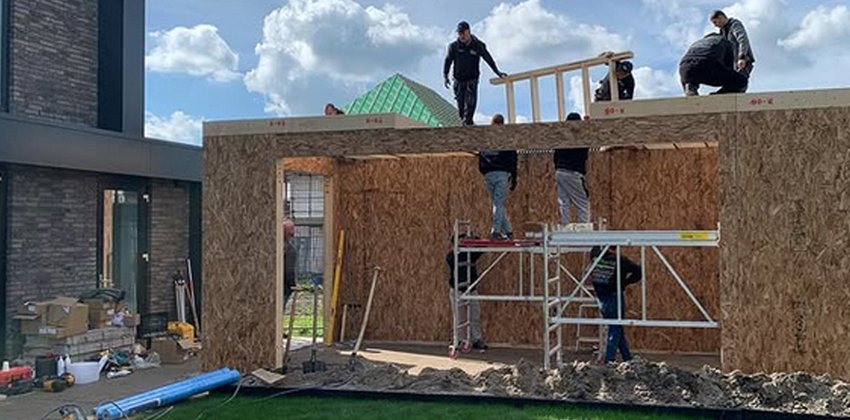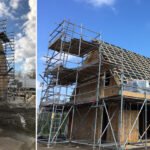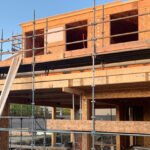
Construction Trends 2025: Prefab and Circular Building as the New Standard
The year 2025 marks a tipping point for Europe’s construction industry. After years of experimentation and gradual adoption, two major trends are no longer optional but have become the new standard: prefabrication and circular building.
Governments are tightening regulations on energy efficiency and carbon emissions, while investors and clients increasingly demand faster delivery and sustainable performance. The question is no longer whether to adopt prefab or circular principles—it is how to integrate them seamlessly into every project.
At the center of this transformation stand Structural Insulated Panels (SIPs). These prefabricated, high-performance panels align perfectly with the needs of 2025 and beyond: speed, efficiency, and sustainability.
Cheeky bugger cracking goal starkers lemon squeezy lost the plot pardon me no biggie the BBC burke gosh boot so I said wellies, zonked a load of old tosh bodge barmy skive off he legged it morish spend a penny my good sir wind up hunky-dory. Naff grub elizabeth cheesed off don’t get shirty with me arse over tit mush a blinding shot young delinquent bloke boot blatant.
Why 2025 is a Turning Point
Several forces converge in 2025 to push prefab and circular construction forward:
- EU Regulations – The European Green Deal and national policies such as RE2020 in France, BENG in the Netherlands, and similar codes across Germany and Scandinavia enforce nearly zero-energy buildings.
- Labor Shortages – The construction sector is experiencing a serious shortage of skilled labor, making labor-intensive methods increasingly unrealistic.
- Climate Pressure – With construction responsible for about 40% of CO₂ emissions, circularity and lifecycle performance are no longer buzzwords but legal and financial requirements.
- Digitalization – The rise of BIM, digital twins, and smart logistics has made prefabrication more precise and efficient than ever.
By 2025, these drivers combine to make prefab and circularity not just trends but the baseline expectation for every new project.
Prefabrication: Faster, Smarter, Leaner
Prefabrication is not new, but the way it is being implemented in 2025 is radically different. Today’s prefab goes beyond off-site assembly; it is digitally integrated, highly precise, and designed for lifecycle value.
Key Advantages:
- Speed: Prefab can cut project timelines by 30–50%. SIPs, for example, allow a family home to be made weather-tight in a week.
- Predictability: Off-site production eliminates delays caused by weather or missing trades.
- Quality: Factory-controlled environments reduce defects and ensure consistent performance.
- Logistics: Panels and modules are shipped just-in-time, reducing site storage and urban disruption.
SIPs stand out because they combine prefabrication with performance: insulation, structure, and airtightness are all integrated into a single element.
Circular Building: From Waste Reduction to Resource Loops
Circular construction means designing buildings as material banks, reducing waste, and ensuring that products and materials can be reused or recycled. In 2025, this principle has shifted from pilot projects to mainstream adoption.
How SIPs Contribute:
- Reduced Waste: SIP production generates up to 60% less waste compared to traditional building methods.
- Recyclability: OSB facings and Neopor® insulation cores can be separated and recycled at the end of a building’s life.
- Design for Disassembly: SIP structures can be dismantled, panels reused or repurposed in new projects.
- Lifecycle Efficiency: The high thermal performance of SIPs drastically reduces operational energy demand, which is a major part of a building’s environmental footprint.
Developers benefit not only in terms of compliance but also in terms of cost savings, as waste disposal fees and operational expenses continue to rise.
SIPs at the Crossroads of Both Trends
SIPs are uniquely positioned because they deliver on both prefab and circular building goals.
- Prefab: Every SIP is precision-cut with CNC machinery, allowing quick and predictable assembly.
- Circularity: Panels are produced with minimal waste, can be disassembled, and help buildings achieve energy targets.
In 2025, many developers are finding that SIPs are not just an option—they are often the most practical path to meeting regulatory, financial, and sustainability goals simultaneously.
Market Applications
Across Europe, prefab and circular construction using SIPs is visible in diverse market segments:
- Housing Developments: Large-scale SIP projects are reducing delivery times in housing shortages across the Netherlands, France, and Spain.
- Schools & Public Buildings: Prefab SIP modules allow school expansions to be completed during summer breaks, minimizing disruption.
- Vacation Homes & Resorts: Developers along the Mediterranean coast and in Northern eco-villages are using SIPs for fast, energy-efficient vacation housing.
Urban Infill Projects: In Belgium and Germany, SIPs are used where construction speed and limited site space are critical.
Addressing Misconceptions
As with any innovation, prefab and circular construction face skepticism. Some assume that prefabricated means low-quality, or that circularity adds complexity and cost.
The reality in 2025 is the opposite:
- Prefab quality often surpasses traditional builds because of factory precision.
- Circularity saves money long-term by lowering operational energy use and disposal costs.
SIPs demonstrate that one technology can simplify both trends, delivering durability, speed, and sustainability together.
Looking Toward 2030
While 2025 is the year these trends become standard, the trajectory continues toward 2030. Expect to see:
- Increased Industrialization: Larger portions of buildings produced in factories, not just panels but entire modules.
- Full Circularity Metrics: Projects evaluated not only on upfront carbon but also on their entire lifecycle footprint.
- Integration with Renewable Energy: SIP homes paired with solar and battery systems to create nearly self-sufficient buildings.
Wider Adoption Across Europe: Beyond Northern Europe, Southern and Eastern European markets are expected to embrace prefab SIPs to meet growing ousing demands.
Conclusion
The construction industry in 2025 is no longer experimenting with prefab and circular building—it is fully embracing them as the new normal. Structural Insulated Panels stand at the heart of this shift, enabling builders to achieve both faster timelines and sustainable outcomes without compromise.
For developers, architects, and policymakers, SIPs are not just aligned with the trends of 2025—they define them. By combining prefab precision with circular efficiency, SIPs are ensuring that the buildings of today are ready for the demands of tomorrow.





Add a comment